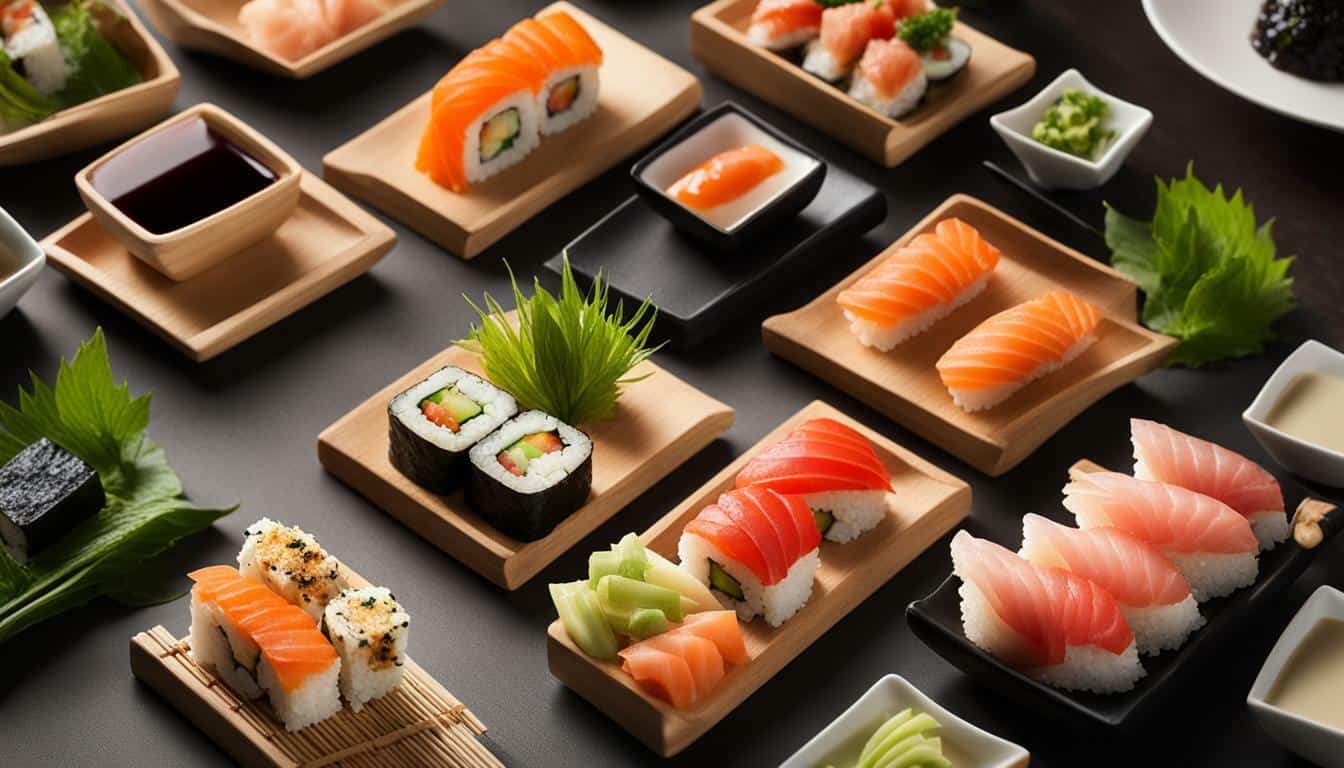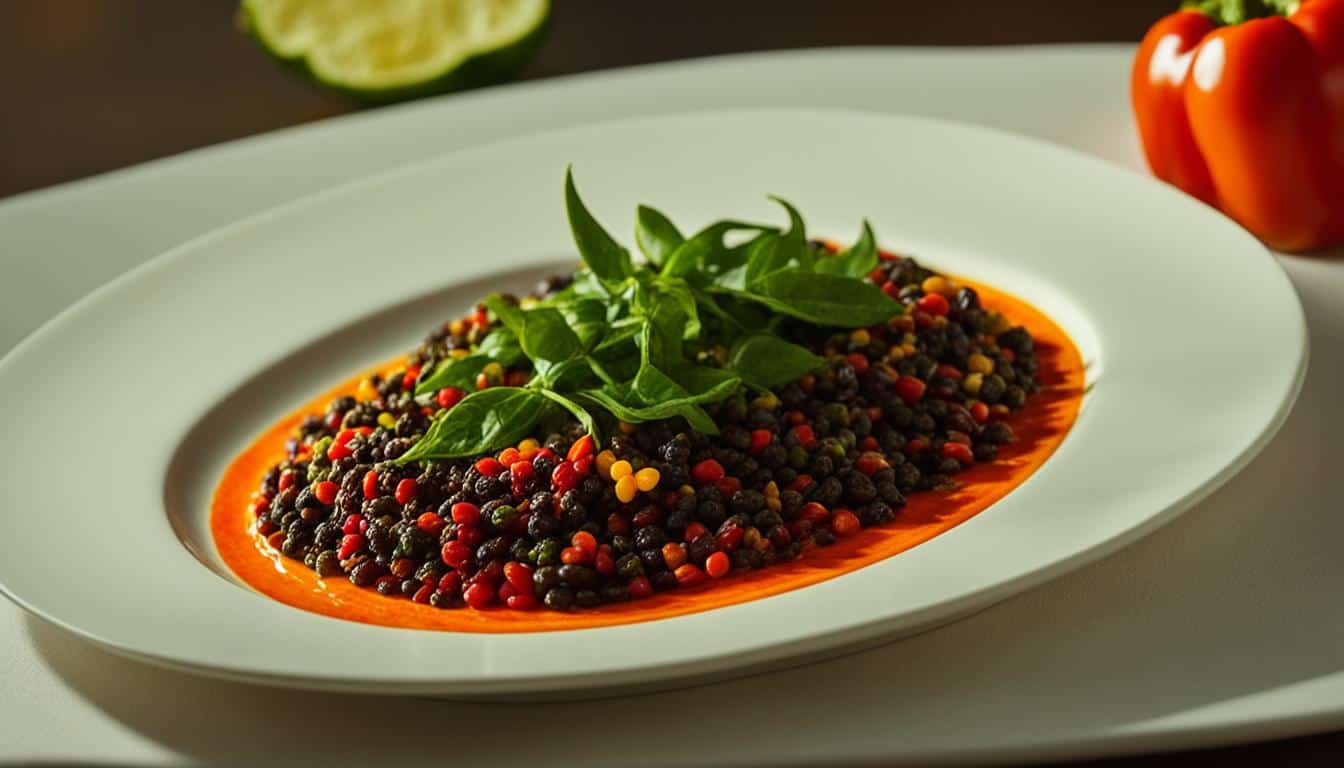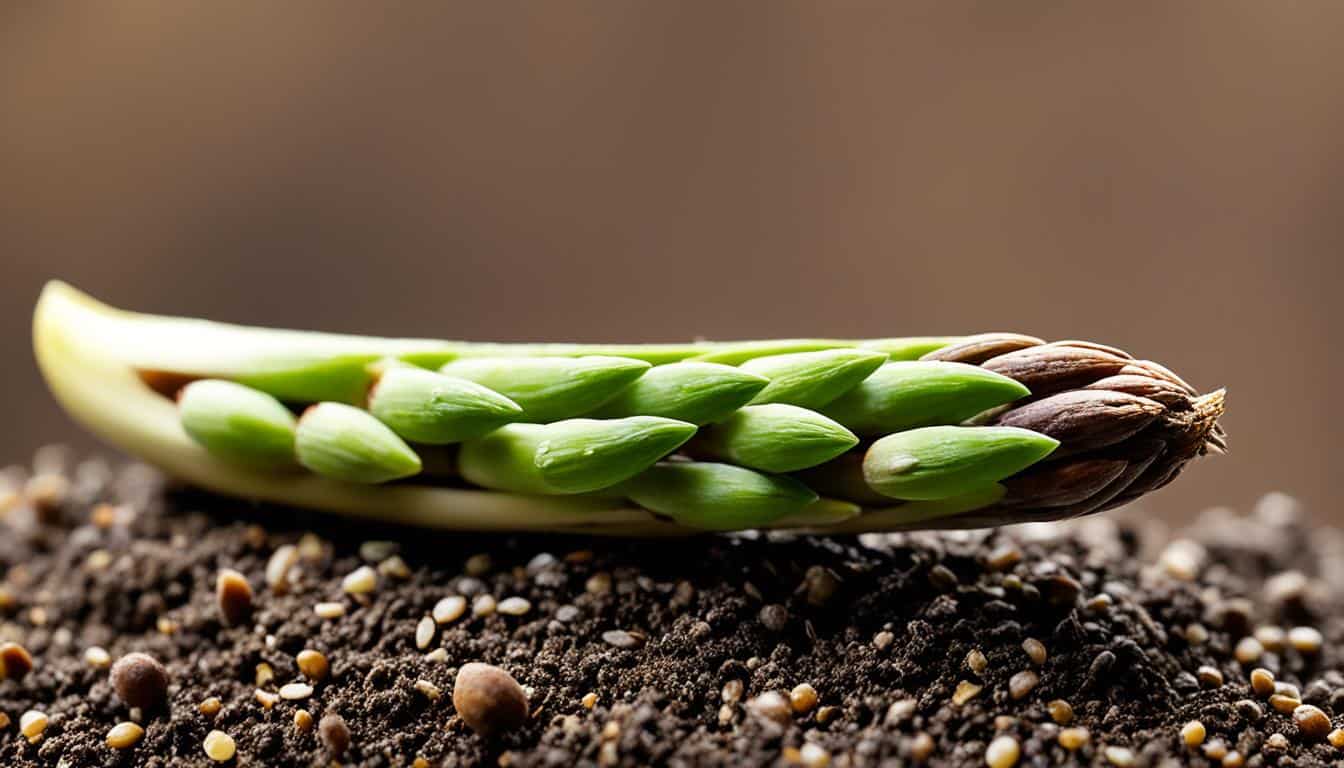Sushi is a beloved culinary delight that has gained popularity around the world. But have you ever wondered what exactly makes up this delectable dish?
Sushi, the iconic Japanese dish, is made with a combination of three main ingredients: vinegared rice, nori (seaweed), and a variety of fillings. The vinegared rice forms the heart of sushi, while the nori adds a touch of flavor and texture. The fillings, which can range from raw or cooked seafood to vegetables or meat, provide the diverse flavors that sushi is known for.
Key Takeaways:
- Sushi is made up of vinegared rice, nori (seaweed), and a variety of fillings.
- Vinegared rice is the foundation of sushi, giving it a sweet and sour taste.
- Nori adds flavor and texture to sushi.
- The fillings in sushi can include raw or cooked seafood, vegetables, or meat.
- There are different types of sushi, including nigirizushi, maki, and chirashizushi.
Exploring the Essential Ingredients in Sushi
The essence of sushi lies in its three core ingredients, which come together to create a harmonious blend of flavors and textures. These essential ingredients are the foundation of any sushi creation, and understanding their role is essential for appreciating this iconic Japanese dish.
“Sushi is more than just raw fish and rice. It is an art form, carefully crafted with precision and attention to detail.”
The first and most crucial ingredient is vinegared rice. Traditional sushi is made with medium-grain white rice that is mixed with vinegar, sugar, and salt. This combination gives the rice a delicate sweet and sour taste, perfectly complementing the other ingredients.

The second key ingredient is nori, a type of edible seaweed that adds a unique taste and texture to sushi. Nori is used to wrap the rice and fillings, providing a crispy element to the overall experience. It also serves as a natural umami enhancer, enhancing the flavors of the other ingredients.
Lastly, sushi offers a wide variety of fillings that cater to different tastes and preferences. From raw and cooked seafood like salmon, tuna, and shrimp, to vegetarian options like cucumber and avocado, the possibilities are endless. The combination of fillings with the vinegared rice and nori creates a symphony of flavors that can be enjoyed in each bite.
The Perfect Balance
When these essential ingredients come together, sushi becomes a culinary masterpiece. The balance between the tangy rice, the briny nori, and the flavorful fillings is what sets sushi apart and makes it a favorite among food enthusiasts worldwide.
So the next time you indulge in a plate of sushi, take a moment to appreciate the artistry and skill that goes into creating this beloved dish. Each bite is a taste of Japan’s rich culinary heritage, where simplicity and balance are celebrated in every aspect of the cuisine.
| Type of Sushi | Description |
|---|---|
| Nigirizushi | Hand-pressed sushi with a slice of fish or other topping on top of a small bed of rice |
| Maki | Rolls of sushi with rice and fillings wrapped in nori and sliced into bite-sized pieces |
| Chirashizushi | A bowl of sushi rice topped with a variety of ingredients, often served as a colorful and flavorful sushi salad |
The Heart of Sushi: Vinegared Rice
At the center of every sushi roll is a bed of perfectly seasoned rice, known as sushi rice. This essential ingredient is the foundation that holds all the other components together, ensuring that every bite is a harmonious blend of flavors and textures.
To create sushi rice, short-grain white rice is cooked and then gently seasoned with a mixture of rice vinegar, sugar, and salt. The vinegar gives the rice a tangy and slightly sweet taste, while the sugar and salt add balance and enhance the overall flavor profile. The precise ratio of these ingredients is crucial to achieving the desired taste and texture.
Traditional sushi rice is sticky in nature, which allows it to be easily shaped and molded into various forms. It acts as a cohesive element, holding the fillings together and providing a stable base for the nori (seaweed) wrap. The stickiness of sushi rice is what gives each sushi roll its distinct shape and structure.
Wrapping it Up: Nori (Seaweed)
The outer layer of sushi rolls is made using a sheet of nori, a nutrient-rich seaweed that adds a distinct flavor and texture. Nori is harvested from the ocean and then dried and roasted before being used in sushi preparations. It is commonly available in thin, rectangular sheets that are dark green or black in color.
Nori brings a unique umami taste to sushi, enhancing the overall flavor profile of the dish. It has a slightly salty and slightly sweet taste, which pairs well with the other ingredients like rice and fillings. The texture of nori is also noteworthy, as it provides a satisfying crunch when bitten into, adding an enjoyable aspect to each sushi bite.
Aside from its culinary attributes, nori also boasts several health benefits. It is a rich source of vitamins and minerals, including iodine, calcium, iron, and antioxidants. Additionally, nori is low in calories and fat, making it a guilt-free addition to any sushi feast.
In summary, nori plays a crucial role in sushi, both from a taste and nutritional standpoint. Its distinct flavor and texture make it an essential component of sushi rolls, and its health benefits make it a desirable choice for those seeking a nutritious meal. So, the next time you indulge in sushi, appreciate the contribution of nori to this iconic Japanese delicacy.

Sushi offers an endless array of fillings, ranging from fresh fish to crispy vegetables, allowing for endless creativity and flavor combinations. The choice of filling is what sets each sushi roll apart and provides a unique dining experience. Here are some of the most popular fillings found in sushi:
- Raw Fish: Sashimi-grade fish, such as tuna, salmon, and yellowtail, are commonly used in sushi. Their delicate flavors and tender textures complement the rice and seaweed perfectly.
- Cooked Seafood: Shrimp, crab, and eel are often cooked and incorporated into sushi rolls. These ingredients add a rich and savory element to the overall taste.
- Vegetables: Crisp and colorful vegetables like cucumber, avocado, and carrot provide a refreshing crunch and balance the flavors in sushi. They also offer a vegetarian-friendly option.
- Meat: In addition to seafood and vegetables, sushi can also feature cooked or marinated meats such as beef, chicken, or even pork belly. These additions give sushi a heartier and more indulgent twist.
Combining different fillings is where the art of sushi-making truly shines. Chefs often experiment with unique combinations, creating rolls that cater to various taste preferences. From classic combinations like tuna and avocado to more adventurous pairings like mango and shrimp, there is a sushi roll for every palate. The possibilities are endless, limited only by the chef’s imagination.

When it comes to sushi, the fillings are just as important as the rice and seaweed. They contribute to the taste, texture, and overall enjoyment of the dish. So next time you indulge in sushi, explore the variety of fillings available and discover your new favorite combination!
Serving Sushi: Accompaniments and Condiments
Enjoying sushi is not complete without the perfect accompaniments, such as pickled ginger, fiery wasabi, and savory soy sauce. These flavorful additions enhance the taste and experience of each sushi bite, adding an extra level of excitement to the already delicious dish.
First, let’s talk about pickled ginger, also known as gari. This delightful pink condiment is made from thinly sliced young ginger roots pickled in a mixture of vinegar and sugar. Its refreshing and slightly tangy taste is the perfect palate cleanser between different sushi rolls or sashimi. Just a small nibble of pickled ginger before tasting the next piece of sushi helps to cleanse the palate and prepare it for the next flavor explosion.
Next, we have wasabi, a pungent green paste made from the root of the wasabi plant. Known for its intense spiciness, wasabi adds a fiery kick to the sushi experience. A small dab of wasabi on top of a piece of sushi can elevate the flavors and provide a delightful sensation that lingers on the taste buds. However, be cautious as wasabi can be quite strong, so use it sparingly to avoid overpowering the delicate flavors of the sushi.
Lastly, soy sauce, or shoyu, is a staple condiment in Japanese cuisine. This dark, salty sauce is made from fermented soybeans and wheat. When enjoying sushi, a small dish of soy sauce is usually provided for dipping. The sushi can be lightly dipped into the soy sauce to add a hint of saltiness and umami flavor. Be mindful not to soak the sushi in soy sauce as it can overpower the delicate balance of flavors.
| Accompaniment | Description |
|---|---|
| Pickled Ginger | A tangy and refreshing condiment made from pickled young ginger roots. |
| Wasabi | A pungent green paste made from the root of the wasabi plant, adding a fiery kick to the sushi experience. |
| Soy Sauce | A dark, salty sauce made from fermented soybeans and wheat, providing a hint of saltiness and umami flavor when lightly dipped. |
These accompaniments and condiments are essential in enhancing the flavors and enjoyment of sushi. Just like a symphony, each ingredient plays a unique role in creating a harmonious and satisfying experience. So, the next time you savor a piece of sushi, remember to appreciate the dynamic trio of pickled ginger, fiery wasabi, and savory soy sauce that complements and completes the culinary masterpiece.
Unraveling the Types of Sushi
Sushi comes in various forms, each with its own unique presentation and preparation method. Whether you’re a sushi enthusiast or a newcomer to this Japanese delicacy, understanding the different types of sushi can enhance your dining experience and broaden your palate. Let’s explore three popular types: nigirizushi, maki, and chirashizushi.
Nigirizushi
Nigirizushi, also known as hand-pressed sushi, is a classic and elegant style of sushi. It consists of a small mound of vinegared rice topped with a slice of fresh fish or seafood. The chef skillfully forms each piece by gently pressing the rice and shaping it with their fingertips. The result is a bite-sized piece of sushi that beautifully showcases the delicate flavors of the fish.
Maki
Maki sushi, also referred to as rolled sushi, is probably the most familiar type to many sushi lovers. It features a layer of nori (seaweed) on the outside, encasing a combination of rice, fillings, and sometimes additional ingredients like avocado or cucumber. The prepared ingredients are carefully rolled together using a bamboo mat, creating a cylindrical shape. Maki sushi is then sliced into bite-sized pieces, offering a delightful mix of textures and flavors with every bite.
Chirashizushi
Chirashizushi, or scattered sushi, is a vibrant and colorful variant of sushi. It consists of a bowl of sushi rice topped with an assortment of thinly sliced sashimi, vegetables, and garnishes. The ingredients are artfully arranged on top of the rice, creating a visually appealing dish resembling a colorful tapestry. Chirashizushi offers a delightful medley of flavors and textures, making it a popular choice for those who enjoy a variety of ingredients in a single dish.
With the knowledge of these three types of sushi, you can confidently navigate the sushi menu and explore the wide array of flavors and textures that this beloved cuisine has to offer. Remember to savor each bite and appreciate the meticulous craftsmanship that goes into preparing these bite-sized delights.

| Type of Sushi | Description |
|---|---|
| Nigirizushi | A small mound of vinegared rice topped with a slice of fresh fish or seafood. |
| Maki | A cylindrical roll of rice, fillings, and nori (seaweed). |
| Chirashizushi | A bowl of sushi rice topped with an assortment of thinly sliced sashimi, vegetables, and garnishes. |
Master the Art of Sushi Making
If you’re feeling adventurous, why not embark on a sushi-making adventure and elevate your culinary skills today? Making sushi at home can be a fun and rewarding experience, allowing you to customize your creations and impress your family and friends. While it may seem intimidating at first, with some practice and the right ingredients, you can become a sushi master in no time.
Start by gathering the essentials: sushi rice, nori (seaweed), and a variety of fillings such as fresh fish, vegetables, or cooked meat. Sushi rice is the heart of any sushi dish, so it’s important to prepare it correctly. Cook the rice until it’s tender, then mix it with a combination of rice vinegar, sugar, and salt. This will give the rice a sticky texture and a delightful sweet and sour taste.
Once the rice is ready, it’s time to assemble your sushi rolls. Lay a sheet of nori on a bamboo sushi mat, then spread a thin layer of rice over it, leaving a small border at the top. Add your choice of fillings along the center of the rice, then use the sushi mat to tightly roll the nori into a cylinder. Slice the roll into bite-sized pieces and arrange them on a serving plate.
To enhance the flavors of your sushi, serve it with traditional accompaniments and condiments. Pickled ginger will cleanse your palate between bites, while wasabi adds a spicy kick. Soy sauce can be used for dipping, but remember to use it sparingly as it can overpower the delicate flavors of the sushi.
Create Your Own Sushi Masterpiece
- Experiment with different fillings and combinations to create your own unique sushi rolls.
- Try using fresh seafood such as salmon, tuna, or shrimp, or opt for cooked options like grilled eel or tempura vegetables.
- Don’t forget about vegetarian options! Avocado, cucumber, and carrot make delicious additions to sushi rolls.
Sushi making is not only about the end result, but also about the journey. Embrace the artistry and precision it requires, and enjoy the process of creating beautiful and delicious sushi. With practice, you’ll soon develop the confidence and skills to impress even the most discerning sushi connoisseurs. So, why not give it a try and elevate your culinary skills today?

As you can see, the three main ingredients in sushi – vinegared rice, nori, and a variety of fillings – are the building blocks of this beloved Japanese delicacy, bringing together a symphony of flavors and textures.
Sushi rice, also known as vinegared rice, is the heart of sushi-making. It is prepared by mixing medium-grain white rice with vinegar, sugar, and salt, resulting in a delightful sweet and sour taste. This perfectly seasoned rice provides the foundation for all types of sushi and plays a crucial role in balancing the overall flavors of the dish.
Another essential component of sushi is nori, a type of seaweed. Nori is used to wrap around the rice and fillings, adding a subtle umami flavor and providing a delicate crunch. It also contributes to the visual appeal of sushi, giving it its signature appearance.
The variety of fillings in sushi is what makes it endlessly customizable and exciting. From raw or cooked seafood like salmon, tuna, or shrimp to vegetables like cucumber, avocado, or pickled radish, and even meat like grilled eel or thinly sliced beef, the possibilities are endless. These fillings provide a burst of different textures, flavors, and colors, ensuring every bite of sushi is a delicious adventure.
Accompanying the sushi, you’ll often find pickled ginger, wasabi, and soy sauce. Pickled ginger adds a refreshing zing to cleanse the palate between different sushi bites, while wasabi provides a spicy kick for those who enjoy some heat. Soy sauce, with its savory and salty taste, is used for dipping the sushi, adding an extra layer of flavor enhancement.
With its various types like nigirizushi, maki, and chirashizushi, sushi offers something for every preference and occasion. Whether you prefer the simplicity of hand-pressed sushi or the complexity of rolled sushi, each type has its own unique charm and taste.
In conclusion, sushi is a culinary art form that captivates taste buds and satisfies appetites worldwide. The combination of vinegared rice, nori, and a variety of fillings creates an unforgettable experience with every bite. So, next time you indulge in sushi, savor the harmony of these three main ingredients that make this Japanese delicacy truly exceptional.
FAQ
Q: What are the three main ingredients in sushi?
A: The three main ingredients in sushi are vinegared rice, nori (seaweed), and a variety of fillings such as seafood, vegetables, or meat.
Q: What type of rice is used in sushi?
A: Sushi is traditionally made with medium-grain white rice, which is mixed with vinegar, sugar, and salt to give it a sweet and sour taste.
Q: What are some common fillings used in sushi?
A: Sushi can be filled with a variety of ingredients such as raw or cooked fish, squid, eel, or imitation crab meat.
Q: What are the accompaniments and condiments served with sushi?
A: Sushi is often served with pickled ginger, wasabi, and soy sauce.
Q: What are the different types of sushi?
A: There are different types of sushi, including nigirizushi (hand-pressed sushi), maki (rolled sushi), and chirashizushi (scattered sushi).
Q: Can I make sushi at home?
A: Yes, you can try your hand at making sushi at home. It’s a fun and rewarding culinary skill to master!
What are the Main Ingredients in Fudge?
The ingredients for fudge discovered today include butter, sugar, and condensed milk. These three main components form the base of traditional fudge recipes. Additional ingredients like chocolate, nuts, or vanilla extract can be added to enhance the flavor and texture. Making fudge requires careful measurement and the right combination of ingredients to achieve that smooth and rich taste we all love.







Leave a Reply